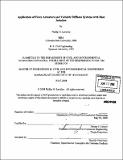Applications of force actuators and variable stiffness systems with base isolation
Author(s)
Lavallee, Phillip M. (Phillip Michael)
DownloadFull printable version (63.53Mb)
Other Contributors
Massachusetts Institute of Technology. Dept. of Civil and Environmental Engineering.
Advisor
Jerome J. Connor.
Terms of use
Metadata
Show full item recordAbstract
Recent developments have occurred that limit the effectiveness of conventional strength-based structural design. First, there has been a trend towards designing more flexible structures that require increased emphasis on structural motion and serviceability. Next, motion has become more important for the design of new facilities that house very sensitive manufacturing and operating equipment. This equipment can only operate properly under extremely low movement conditions. Third, advances in material science and engineering have led to developing materials with significantly increased strengths, but the stiffness of these materials have not increased at the same rate. Motion parameters control the design for these high-strength materials. Finally, recent earthquake responses have shown that repair costs from structural damage due to inelastic deformation that was much greater than anticipated. This has led to a trend in reducing the reliance on inelastic deformation in the structure to dissipate energy, and designing control of the response with other energy dissipation and absorption devices. Motion-based design is more effective to address the developments mentioned above. To control the motion of civil structures from earthquake excitations, base isolation systems have become more common to uncouple the structure from the ground. Base isolation reduces the lateral stiffness of the bottom floor to allow large movement of the structure as a rigid body for earthquake excitations. For lower service loads such as wind, the lateral stiffness of the isolation bearings is insufficient to prevent the structure from large movement and uplift. Variable stiffness systems have been used to adjust lateral stiffness based on the size of the load experienced. (cont.) This thesis proposes using force actuators to increase and decrease lateral stiffness by clipping and unclipping horizontal members when the ground acceleration reaches preset threshold limits. When clipped, the structure responds as a conventional strength-based designed structure. When unclipped, the structure responds as a base isolated structure. After an event is complete, the actuators re-clip and the structure is prepared for the next event.
Description
Thesis (M. Eng.)--Massachusetts Institute of Technology, Dept. of Civil and Environmental Engineering, 2008. Includes bibliographical references (p. 77-78).
Date issued
2008Department
Massachusetts Institute of Technology. Department of Civil and Environmental EngineeringPublisher
Massachusetts Institute of Technology
Keywords
Civil and Environmental Engineering.